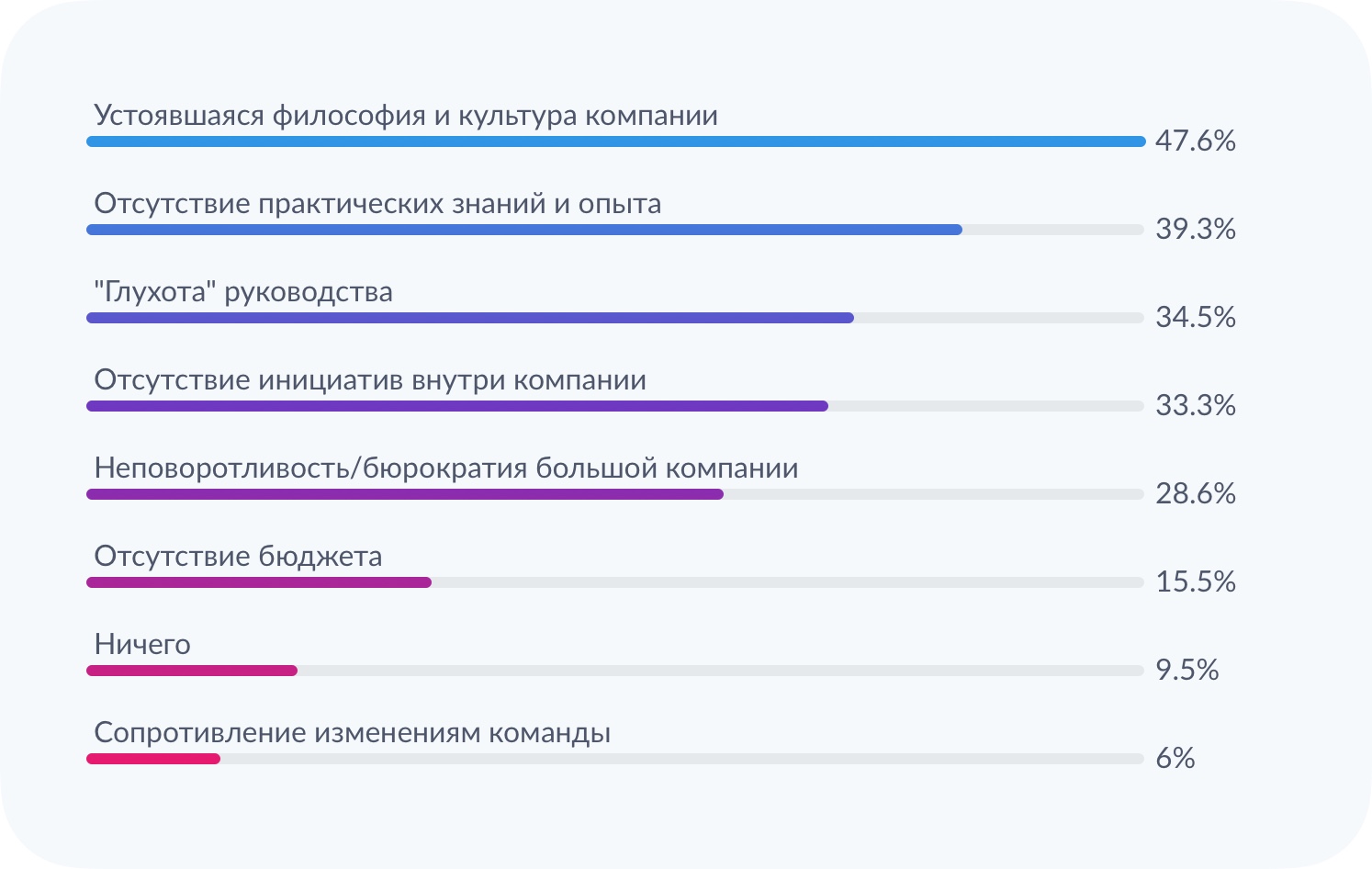Agile in Russia - 82.9% of companies report that they use at least something from Agile. First poll results
There is great research and infographics about how Agile is spread throughout the world. This can be inspired, but the conclusions are very far from our reality. There are simply very few respondents from the post-Soviet space.
We are developing a project management system , including for managing Agile projects. It is vitally important for us to understand how things are going with the application of the methodology in companies and what are the most common problems in project management.
We regularly draw conclusions from direct communication with customers. We collect all the Wishlist on the system from users and build a picture of appeals. But the largest number of insights appeared now, after the launch of the survey . 300 respondents have already accumulated (goal 1500) and the first results can be viewed and discussed.
')

Under the cut the first graphs, conclusions, reasoning and a call to take the survey.
82.9% report that the methodology is somehow used in the company. Interestingly, according to a survey of the above in the world, this figure is 94%. Not such a big difference. It's great! There is a huge sense in the development of project and company management approaches. The success of any single country really depends on it. In the industrial age, they learned how to make a conveyor belt, now they are learning how to create effective project teams.
45.7% chose a confident position: “we work according to a flexible methodology”. In practice, we most often encounter companies from the blue sector - using a little bit of Agile. Either when dealing with us, companies try to speak more carefully about their approaches, or we work more with those who are just starting.

The overwhelming majority (71.3%) for the fact that Agile is a method of conducting project activities applicable in many areas, not only in development. Communicating with companies directly, we sometimes come up against the position: “We only have a website out of development, Agile is not suitable for us”. At the same time, the company may be engaged in the creation of individual house projects, where an iterative approach, open communication with the customer, regular demonstrations, agile boards, team planning priorities, etc. will be in place.
22.3% is a little surprised - “This is a way to organize a company in which people feel freer . " We met this opinion (and therefore added to the survey), but rarely, and for those who dealt with this topic only in theory. When there is more answers, you can reliably know that this segment answered the question “Does Agile apply to your company?” or “Which methods have you ever used?” Perhaps we are missing something and this definition is really well suited for understanding and introduction to the team.

Respondents could choose several options.
In the first place is “Managing Changing Priorities” - 67.4% . Well, indeed - the very idea of the methodology is based on being more flexible and changing as priorities change.
Interestingly, 14.6% chose to reduce the cost of the project . When I first met, Agile did not look cheap at all. You can get such a result only if you get burned a couple of times on the cascade method and understand that moving in small iterations with the analysis of intermediate results will end up being cheaper.
61.8% voted that Agile increases the transparency of the project. In practice, this is the first instant effect, which is achieved if the team began to plan tasks on an agile board, which we think is better in the management system, but it can be done on the marker with colored stickers.

Respondents could choose several options.
When the survey was just beginning and there were about 50 respondents confidently leading the “Deafness of the leadership”, and now the “Established culture and philosophy of the company” is clearly winning with 47.6%. And this option is, of course, much more honest. It’s not the leadership that becomes sluggish, but the whole company gets used to something and it becomes more and more difficult to change.
For good accuracy, I want to collect 1,500 respondents. In a survey of 12 questions, about 3 minutes takes a walkthrough.
Pass the survey and send the link to friends
We will complete the full results well and post it here in a couple of weeks.
If at the end of the survey leave mail (optional), then send a report in priority order.
We are developing a project management system , including for managing Agile projects. It is vitally important for us to understand how things are going with the application of the methodology in companies and what are the most common problems in project management.
We regularly draw conclusions from direct communication with customers. We collect all the Wishlist on the system from users and build a picture of appeals. But the largest number of insights appeared now, after the launch of the survey . 300 respondents have already accumulated (goal 1500) and the first results can be viewed and discussed.
')
Can you say that Agile is used in your company?

Under the cut the first graphs, conclusions, reasoning and a call to take the survey.
82.9% report that the methodology is somehow used in the company. Interestingly, according to a survey of the above in the world, this figure is 94%. Not such a big difference. It's great! There is a huge sense in the development of project and company management approaches. The success of any single country really depends on it. In the industrial age, they learned how to make a conveyor belt, now they are learning how to create effective project teams.
45.7% chose a confident position: “we work according to a flexible methodology”. In practice, we most often encounter companies from the blue sector - using a little bit of Agile. Either when dealing with us, companies try to speak more carefully about their approaches, or we work more with those who are just starting.
Which of the definitions of “Agile” best fits your understanding?

The overwhelming majority (71.3%) for the fact that Agile is a method of conducting project activities applicable in many areas, not only in development. Communicating with companies directly, we sometimes come up against the position: “We only have a website out of development, Agile is not suitable for us”. At the same time, the company may be engaged in the creation of individual house projects, where an iterative approach, open communication with the customer, regular demonstrations, agile boards, team planning priorities, etc. will be in place.
22.3% is a little surprised - “This is a way to organize a company in which people feel freer . " We met this opinion (and therefore added to the survey), but rarely, and for those who dealt with this topic only in theory. When there is more answers, you can reliably know that this segment answered the question “Does Agile apply to your company?” or “Which methods have you ever used?” Perhaps we are missing something and this definition is really well suited for understanding and introduction to the team.
What tasks of project activity does Agile help you solve?

Respondents could choose several options.
In the first place is “Managing Changing Priorities” - 67.4% . Well, indeed - the very idea of the methodology is based on being more flexible and changing as priorities change.
Interestingly, 14.6% chose to reduce the cost of the project . When I first met, Agile did not look cheap at all. You can get such a result only if you get burned a couple of times on the cascade method and understand that moving in small iterations with the analysis of intermediate results will end up being cheaper.
61.8% voted that Agile increases the transparency of the project. In practice, this is the first instant effect, which is achieved if the team began to plan tasks on an agile board, which we think is better in the management system, but it can be done on the marker with colored stickers.
What makes it difficult to introduce new approaches in your company?

Respondents could choose several options.
When the survey was just beginning and there were about 50 respondents confidently leading the “Deafness of the leadership”, and now the “Established culture and philosophy of the company” is clearly winning with 47.6%. And this option is, of course, much more honest. It’s not the leadership that becomes sluggish, but the whole company gets used to something and it becomes more and more difficult to change.
Some more interesting preliminary conclusions:
- The excel spreadsheet is the second most popular project management tool (28%)
- The most popular problem in projects - deadlines delayed (74%)
- Almost everyone believes that you need to plan more and set goals more accurately (91%)
- Only a small part of the companies will definitely not develop Agile in the next two years (9%)
- About half of the companies do not understand what is happening in the project (46%)
- Iterative planning is the most popular Agile method (62%)
- A quarter of respondents believe that you just need to dismiss a substantial part of useless employees and projects will be more successful. (25%)
The survey continues
For good accuracy, I want to collect 1,500 respondents. In a survey of 12 questions, about 3 minutes takes a walkthrough.
Pass the survey and send the link to friends
We will complete the full results well and post it here in a couple of weeks.
If at the end of the survey leave mail (optional), then send a report in priority order.
Source: https://habr.com/ru/post/340936/
All Articles